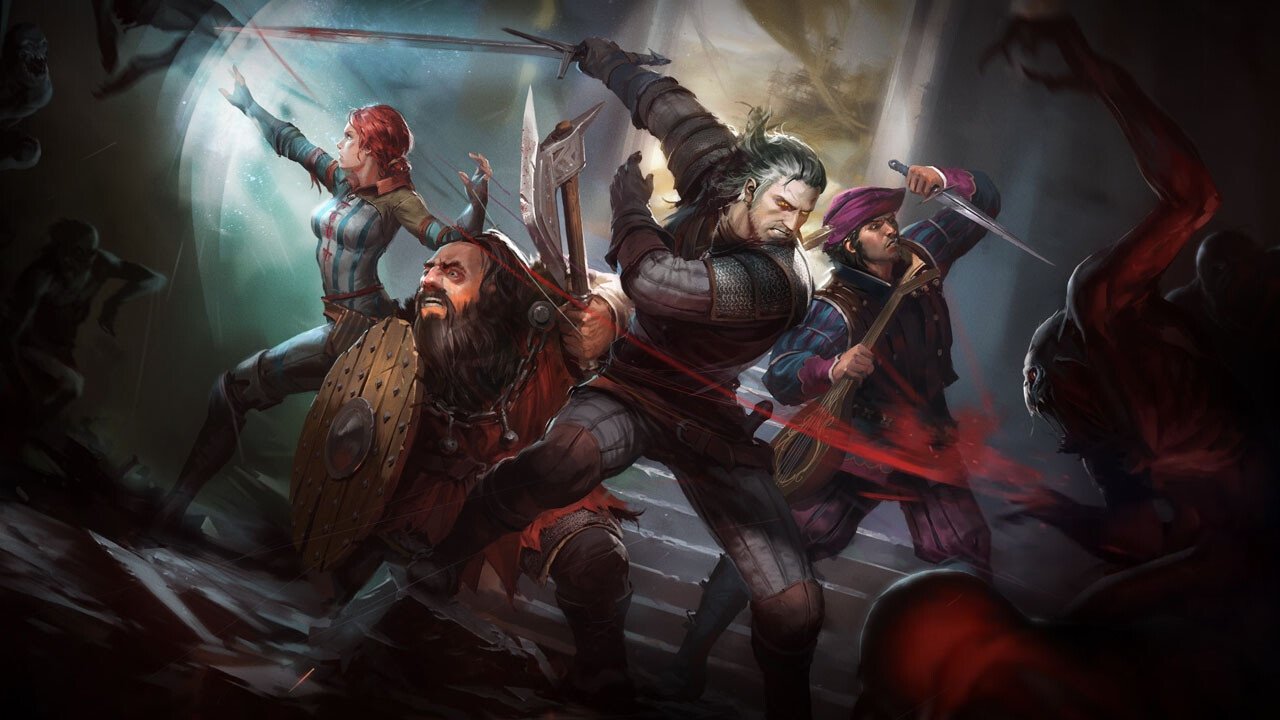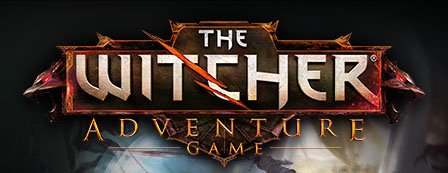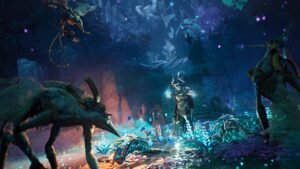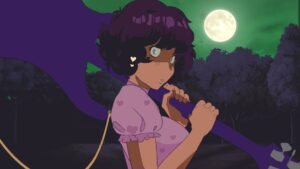I don’t like the Witcher series much – I can’t read the books due to my lack of any skill in Polish or really any other language other than English, and the games’ universe turns me off due to some of the elements regarding characterization (particularly of Garrett) and the baffling universal knowledge of anatomy in a low-fantasy medieval setting. None of these elements are particularly present in this digital board game, and so I don’t let it affect my judgement.
This cuts both ways, though, as a primary selling point of The Witcher Adventure series is the name recognition of playing as regulars such as eponymous monster-hunting mutant Witcher Garrett of Rivia, the sorceress Triss Merigold, the bard Dandelion, and the dwarven warrior Yargen. In truth, that’s the logic behind most licensed games, and the subset of the industry has a reputation for containing some truly mediocre or just plain bad games, and while this isn’t necessarily one of them, it may not appeal to you for very long
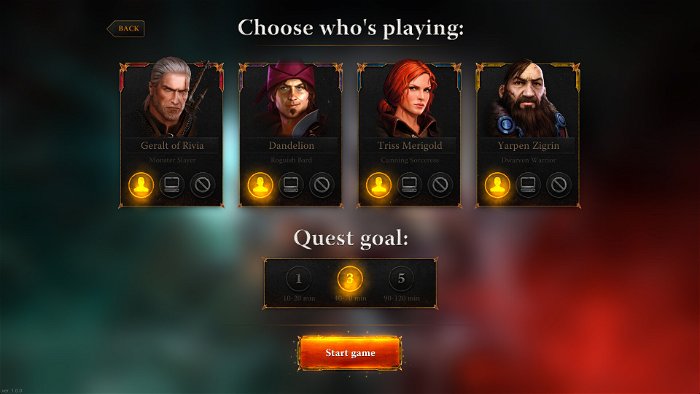
The Witcher Adventure Game places up to four players, using the four named characters mentioned above, on a board detailing the world of the Witcher novels. The goal is to complete quests, detailed on cards which give some plot elements (encourage a crazy mage to leave town, win a tournament, and so forth), with a main goal and some ‘side quests’. Both require resources in the form of three types of “investigation” tokens, Diplomacy, Magic, and Combat, which are exchanged for the quest-completing Proofs when you gather five of a type. Fulfilling side quests or the main quest gives you victory points, the goal of which is to have the most at the end of the game. These are the basics, but there are different systems present in this game – it’s a more complicated board game, much like Settlers of Catan, with multiple resources and events complicating matters. Moving is a simple action that moves you one city, or fast-travel to move two (and suffer a foul fate). Other actions include drawing various cards and fulfilling card requirements by spending your many resources.
It’s complicated, and while the tutorials explain everything, simply jumping in can be daunting. There are several types of cards besides quest cards, including the meritorious Good Fortune cards, Investigation cards that give mini-tasks to do for rewards, and development cards for each different character that tie into their signature abilities, such as Garrett’s Witcher Signs, or Dandelion’s ‘friends’ he can pay money tokens to help him out. Oh, which reminds me: tokens come in varieties such as money, wound tokens that block your ability to perform actions (see below) and Foul Fate tokens that make you draw said cards. Enemy cards require a roll of ‘hero dice’ , requiring a set number of results (symbols, rather than numbers) to overcome the challenge.
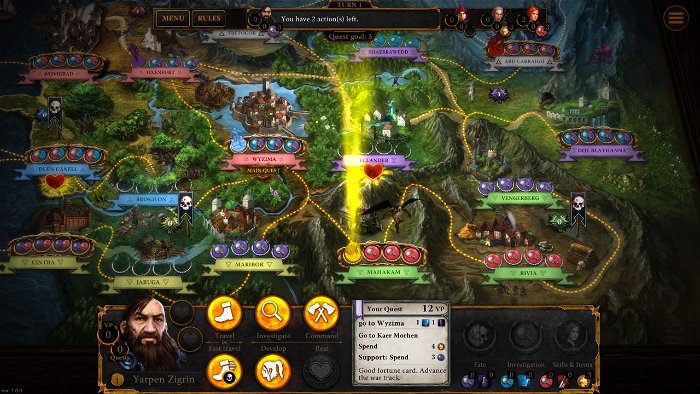
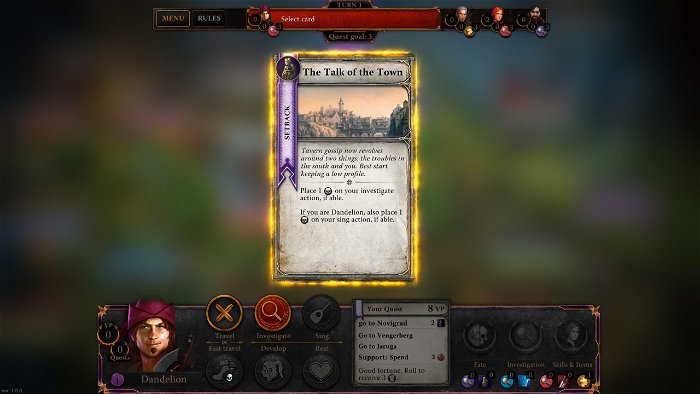
If all this seems confusing, we started on the same page. However, the game doesn’t take more than a few games to get the hang of, even if you blunder through it like I do. The game overdoes it a bit, with features like the war track, a wheel that spawns foul fates and monster cards around the map, makes the game even busier. Combat management largely comes from your character abilities, which allow you to modify your results and are the only way to deal with the highest (gold) difficulty monster cards. Unless you’re Garrett, you can expect to lose most fights or scrape by unless you have properly-funded character Development cards to tip your favour. After that, though, the action used to get those cards becomes largely useless, and can be used as a dumping ground for wounds and foul fates, which you will be receiving liberally even if you excel at the game.
The best way to sum up the game is ‘bad things happen all the time’ – foul fate tokens quickly cover all of your actions, either from enemy cards or from simply moving about the board. Monster cards often have effects applied before the combat resolution which leave you with grievous injuries, and it’s easy to misjudge your assets and take a wound from failing the defensive component. What’s worse, many of the Foul Fate results apply their effects to everyone, or afflict a region with standing fates that you must deal with if no monsters are present (the ability to choose which threat you deal with at the end of your turn is a plus, allowing you to take enemies that fit your skillset).
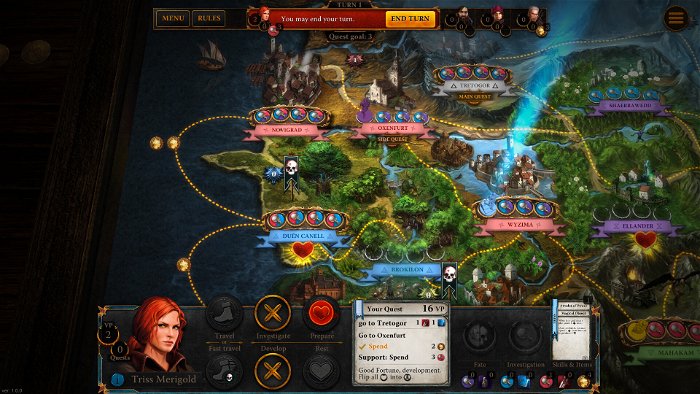
Most games I played had me invariably filling my character options with Foul Fate and wounds, and I would occasionally get caught in a ‘death plummet’ where tragedy heaped onto my character as I simply performed Rest to repair my health. Foul fate/wound tokens with no place to go subtract your victory points, putting you behind and undoing your work. This is a game where you can lose it all, and have to compete and strategize in order to push ahead and beat other players.
Board games often have this, for better or for worse. There’s a sense of joy in watching your opponents fall to chance, and to nudge them towards doom with a well-placed card, or help them along. However, your actual cooperative or competitive actions are limited to moving monsters and foul fates around to other players’ regions, and to fulfilling the Support option on another character’s card to give them some Victory points at the cost of your resources (and gain some for yourself). Overall, there’s a sense of detachment from your other players, as you all race to succeed, largely in your own impenetrable lane. I would have liked more options to hinder other players, or help them, or to actually build Risk-style alliances or work against one another.


What bothers me about this, and what prevents me from having more fun than I did, is that the complexity and the solipsism slows down the experience. I rather enjoyed coming up with a strategy to move about the map, to mitigate disasters and to collect a steady stream of victory points and proofs to save me. However, that feeling faded, and by the end I started to feel like I wanted to stand up and go do something else. Games with other players, on an actual board (which they do sell), might be better, but it still seems like the act of managing will wear on you in time.
The major selling point for me, though, is the lack of mess. All those cards and tokens and dice would be a nightmare to handle in real-life, and would get lost and damaged easily. Cats would be the greatest bane to the Witcher. The online version does away with storage for the most part, and keeps the game more manageable.
Of course, the AI is largely incompetent and easy to beat, so you need to play it with others. Even on single-player, the game often goes far longer than the estimated time per number of quest victories, so expect an hour or two of gameplay, at least. Overall, I think it’s a fun board-game, if not one you’ll play constantly for hours.
